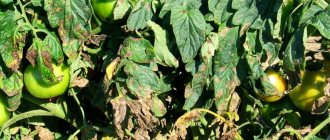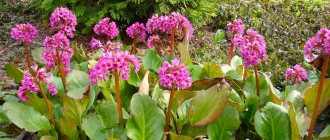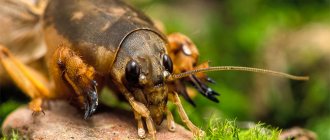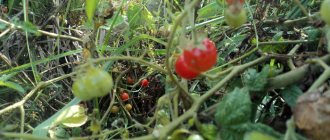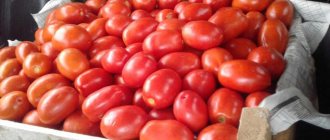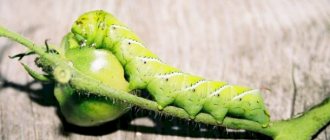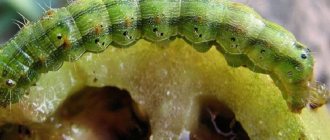Experienced gardeners know firsthand how dangerous late blight is due to its consequences. Late blight on tomatoes can infect the plant regardless of the growing season, causing rapid death of the crop.
In order to prevent the loss of the future harvest, it is necessary to prevent fungal diseases and take timely measures when the first signs appear. Purchased medications and traditional methods will help with this.
The sooner you start treating tomatoes against late blight, the greater the chance of harvesting healthy and tasty fruits. Otherwise, the effort spent on growing the crop will be wasted.
Signs of late blight on tomatoes
Tomatoes become ill with late blight starting in July, when daylight hours decrease, the soil becomes depleted and accumulates many harmful bacteria. At this time, the adult plant directs all its energy to flowering and fruiting.
The disease can be identified by the following signs:
- The appearance of brown spotting on the green above-ground mass;
- Morning formation of a fluffy coating on the underside of the leaves;
- Accelerated drying of foliage in dry weather;
- Covering the fruit with rot (brown spots form under the skin).
Late blight spreads mainly from the bottom up - moist soil evaporates pathogenic bacteria, which settle on the root collar, lower leaves and stepsons.
Accordingly, the use of different remedies for late blight does not guarantee 100% recovery of the tomato. It is very important to follow high-quality agricultural practices.
Reasons for appearance
It is worth highlighting several reasons for the occurrence of late blight in a greenhouse, the main one is excess moisture , it appears:
- With poor or no ventilation.
- With a small distance between tomato bushes.
- Failure to comply with crop rotation rules.
- With frequent or improper watering.
- Under the influence of fog.
- The proliferation of fungal spores is also provoked by a sharp change in temperature, warm day - cool night.
One of the reasons for the appearance of late blight in a greenhouse is excessive fertilizing with nitrogen.
Important! To avoid late blight infection, it is prohibited to plant nightshade plants, especially potatoes, near the greenhouse with tomatoes.
Prevention of late blight on tomatoes
Before you start preparing different solutions from improvised means, you need to put the beds in order. Moreover, tomato agricultural technology is relevant even when late blight is absent.
The thing is that a fungal disease is easier to prevent than to eliminate:
- Firstly, tomatoes must be mulched with a thick layer of straw or dry leaves to allow for ground evaporation;
- Secondly, after precipitation, it is recommended to loosen the row spacing and fill it with ash to deoxidize the soil;
- Thirdly, any plantings that shade the tomato must be pruned;
- Fourthly, tomatoes must be fed with complex fertilizers with a balanced NPK content;
- Fifthly, the lower shoots and leaves are removed so that the bushes are well ventilated and grow evenly;
- Sixth, every two weeks the tomato beds are treated with folk or biochemical remedies against late blight.
It is also recommended to grow blight-resistant varieties. If the seeds were obtained independently, then before planting they must be soaked for one hour in a 2% solution of potassium permanganate.
Features of the fight against the disease
Experienced gardeners believe that it is completely impossible to get rid of this disease.
It is especially difficult to do this in the confined space of a greenhouse; in 2-3 days, late blight, under favorable conditions, can destroy up to 80% of tomatoes.
To avoid disease and get a good harvest, you need to take protective measures to protect the plants.
Considering that fungal spores can be found on all surfaces of the structure, it is necessary:
- Carry out measures to disinfect the walls of greenhouses and soil.
- Use tools designated only for work in the greenhouse.
- Monitor the air temperature, avoiding sudden changes.
- Proper watering and ventilation.
- Carry out preventive measures to treat tomatoes with special means.
Copper wire for treating late blight on tomatoes
Despite the popularity of various solutions, vegetable growers are always looking for new means to combat fungal diseases.
It turns out that cutting copper wire into the trunk of a tomato helps to harden the vegetable and destroy fungal spores using copper (it is not without reason that copper sulfate is one of the effective remedies for late blight).
The thematic procedure goes as follows:
- Copper wire with a diameter of no more than 1 mm is cleaned and cut into 4-5 cm pieces;
- One end of each segment is bent into a hook so that the wire can be easily removed from the barrel if necessary;
- The sharp end of a copper piece cuts into the trunk of a 100-day-old seedling or adult plant at a 10-centimeter height from the ground.
From the moment of “implantation” the tomato does not need such a chemical element as copper. The need to use drugs against late blight is reduced by 2-4 times. In addition, copper wire protects against other fungal spores.
Where can it come from?
When planting beautiful and healthy tomato seedlings in a greenhouse, you need to know that this does not guarantee a good harvest. For several years, a fungal infection, late blight , has been living in the soil; it may not manifest itself in any way. Only under certain conditions in the greenhouse does this type of fungus multiply and damage tomatoes.
It should also be taken into account that fungal spores can be introduced with tools, on clothing, in the soil of seedlings, by wind, etc. Late blight tends to change and mutate, which complicates the fight against this fungus.
Iodine-milk solution for treating late blight in tomatoes
Iodine is used as a disinfectant. But its small capacity may not be enough even to process one bed. There is no point in diluting iodine with water, because... the aqueous solution quickly drains from the green mass. Another thing is milk.
When boiled, it turns out to be absolutely safe, and when it gets on the leaves, it dries quickly, forming a film. Together with iodine, the film will serve as a healing plaster.
All that remains is to prepare a thematic solution:
- 2 liters of milk should be boiled for 15-20 minutes;
- Next 0.5 tsp. iodine is diluted in milk;
- The next step is to spray the tomato with the solution in clear, windless weather.
To obtain a large volume of solution, milk can be diluted with boiled drinking water in a 1:1 ratio. In this case, the dosage of iodine will have to be increased to one teaspoon. Also, instead of milk, whey or kefir is welcome. In the absence of iodine, you can use potassium permanganate (the dosage remains the same).
Description of the disease
First you need to get to know the enemy in order to know how to get rid of him.
Pathogen
Late blight is caused by the fungus-like organism Phytophthora infestans. It is one of the most dangerous pathogens of tomatoes, causing significant or complete crop losses.
Phytophthora is found on potatoes, tomatoes and other nightshade vegetables. In tomatoes, the disease affects all above-ground plant organs, including fruits. Symptoms of rotting on tomatoes grown in open ground are usually observed depending on the weather in late June and early July, when the pathogen en masse infects early potato varieties. However, in tunnels and greenhouses, symptoms on tomatoes often appear in April.
Symptoms
Signs of late blight:
- First, dark green, watery, then brownish spots appear on the leaves, spreading very quickly over the entire surface of the leaf;
- extensive brown necrosis is visible on the tomato stems;
- Gray-green spots are observed on the fruit, then brown spots and rot, the disease spreads deep into the pulp.
On all infected organs of a tomato under conditions of high humidity, most often at the border of healthy and necrotic tissue, a white-gray coating of the late blight pathogen formed by spores appears.
The causative agent of the disease overwinters on plant debris in the form of oospores or in the form of mycelial hyphae, from which, under favorable conditions, late blight spores and sporangia are formed - a source of primary infections.
The course of the disease can be rapid, especially when grown in greenhouses, which leads to complete wilting of tomatoes within a few days.
What late blight looks like on tomatoes - photo
How to distinguish late blight from gray rot of tomatoes?
At the early stage of late blight disease, spots on the leaves can be mistaken for gray rot. In the case of late blight, a white coating appears on the underside of the spots. Tissues affected by gray rot are covered with a gray, dusty coating of conidial spores.
If in doubt, diseased plant material can be sent to a phytopathological laboratory to identify the pathogen.
Conditions for the development of the disease
- The rapid development of late blight is facilitated by high and prolonged air humidity and wet tomato leaves.
- The optimal temperature for the development of the disease is about 21 ºC.
- Temperature fluctuations (more than 25 degrees Celsius during the day, and less than 18 at night).
The most favorable conditions for the spread of late blight combine 2 factors simultaneously:
- two days during which the temperature (even at night) does not fall below 10 ºC;
- relative humidity of 89% or more for at least 11 hours.
In practice, such conditions can occur throughout the summer (more likely in late summer), especially when rain falls after hot summer days, but the air does not cool.
Ash solution for treating tomatoes from late blight
Ash is an excellent natural septic tank that disinfects and deoxidizes the soil. It is impossible not to note the mineral benefits of ash - the content of potassium, phosphorus, calcium and sodium. The main thing is that the soot is obtained from natural forests.
Only then will it be suitable for preparing an ash solution:
- 1 glass of ash is poured into 1 liter of water;
- The solution is stirred and infused for 24 hours;
- Next, the resulting solution (without sediment) is diluted with 5 liters of warm purified water.
The advantage of the ash solution is its versatility - the treatment can be foliar or root. To enhance the effect, ash can be mixed with a 5% soap solution in a 1:1 ratio.
Useful tips for gardeners
The following recommendations will help minimize the possibility of late blight developing on the site.
- Proper nutrition of tomatoes
Nutrient mixtures with a high potassium content increase the immune system of tomatoes, and therefore improve resistance to disease. The greatest effect of foliar feeding of seedlings is spraying.
- Correct fit
Tomatoes require the right soil. It is important to prevent plantings from being too dense and to carry out weeding and pinching of shrubs in a timely manner.
- Use of products containing copper
One of the means of prevention is spraying tomatoes at the seedling stage with copper sulfate - 0.02%. After the bushes are planted in a permanent place and ovaries appear on three tassels, the leafy part of the plant is treated with Bordeaux mixture.
- Selection of specialized varieties
Today there are a large number of different varietal and hybrid types of tomatoes that have good resistance to late blight. It is recommended to focus on these tomatoes. You can also choose those varieties that have early fruit ripening.
Advice. When using seed material prepared on the farm, it is best to use those seeds that have already been stored for 3 years. Such seeds cease to be carriers of a fungus or virus.
Soap solution for tomatoes
Modern soap contains many stabilizers and dyes. The exception is laundry and tar soap. These products, due to their natural alkali content, have a disinfecting effect:
- Dissolve 35 g of soap shavings or 10 tbsp of liquid soap in 1 liter of purified water;
- After 24 hours, dilute the concentrated solution with 5 liters of warm water.
Spraying with a soap solution is carried out before noon. For better analysis, it is recommended to repeat the topical treatment every four days using solutions from different soaps.
Harvest and storage
On diseased bushes, apparently healthy green tomatoes without brown spots can be preserved. They need to be collected and immersed in warm water (60 °C) for 15 seconds. Before sending the fruits for ripening, they are thoroughly wiped.
They save the tomato harvest with the help of preparations. You can use both red and green fruits. During heat treatment, fungal spores die. It is not dangerous to eat preparations made from fruits picked from diseased bushes.
Garlic solution for tomatoes
Garlic contains many beneficial bacteria and elements that drive away fungal microflora. Heads, arrows and even tops are suitable for preparing garlic solution.
The main thing is not to overdo it with the “vigorous liquid”:
- 200 g of consumables are crushed;
- The mixture is poured into 1 liter of purified water and boiled for 30 minutes;
- The decoction is diluted with 10 liters of purified water and used warm for spraying.
Garlic solution contains many biologically active and chemical elements, so it is recommended to mix it with other (ash or soap) solutions in a ratio of 10:1. Otherwise, the tomato may get burned.
Purchased chemicals
Purchase chemicals in specialized stores for gardeners. They are most often sold in liquid, powder, or granule form. Such products are easy to use and fight the disease most effectively.
What means do most gardeners prefer? Let's consider the TOP 5 most effective, affordable and environmentally friendly drugs for combating tomato late blight:
- "Fitosporin M" is available in the form of powder, paste or liquid. It is used at any stage of plant development. The effectiveness of Fitosporin M is from 65 to 95%.
- "Gamair" - found in the form of tablets or powder. The drug is safe for both plants and humans. In addition to tomatoes, it is used to process grain crops, cucumbers and grapes.
- “Quadris” - in addition to protecting against disease, improves the quality of the crop and increases its shelf life. Refers to fungicides.
- "Ridomil Gold" is widely used by gardeners throughout the country. It is most effective as a prophylactic agent, but also shows excellent results as a medicine. Reviews about it are extremely positive.
- "Thanos" - has a healing effect and is not washed off by watering and rain. Forms a protective film on the leaves that prevents spores from penetrating deeper.
Bacillus solution for tomatoes
Most modern antifungal agents are made from Bacillus subtilis. The latter is a competitor for fungi and therefore keeps them from reproducing.
You can prepare the thematic solution yourself:
- 200 g of chopped hay must be boiled in 1 liter of purified water for 10-15 minutes;
- Leave the solution in a warm place for 3-4 days;
- After the film has formed, the solution of Bacillus subtilis is ready for use.
For greater efficiency, add 1 tsp to the liquid at the time of boiling. chalk, lime or ash. Bacillus hay solution is suitable for spraying and watering.
Rules for processing plants
In order for the effect of drugs used against late blight to be maximum, certain rules must be followed:
- spraying treatment is carried out only on calm and sunny days;
- when using toxic drugs, it is necessary to wear protective equipment;
- It is prohibited to prepare chemical and some other solutions in metal containers to avoid oxidation.
Photo of what late blight looks like on tomatoes
Preventive measures
Prevention of late blight on tomatoes in a greenhouse using folk remedies is carried out immediately after planting the seedlings.
Prevention methods:
- spray tomatoes with a 1% solution of potassium permanganate twice a season;
- remove old leaves and fallen fruits;
- do not allow the soil to dry out;
- observe the humidity regime in the greenhouse;
- keep the air temperature 22-24 degrees;
- ensure there is sufficient lighting;
- apply peat fertilizers;
- water only at the roots;
- remove the top layer of soil in autumn;
- plant seeds that are not infected with late blight.
Reviews from summer residents
Let's see what summer residents say about the fight against late blight.
Oleg : “My parents used only folk remedies to prevent late blight in tomatoes in the greenhouse. I adopted the following methods of struggle from them: saline solution, tincture of garlic with potassium permanganate. My favorite remedy is hydrogen peroxide; after treatment, the tomatoes grow quickly, the greens are bright, they actively bloom and bear fruit.”
Natalya : “I fight late blight in the greenhouse only using folk methods. At the beginning of the season, I cultivate the soil with a 1% solution of potassium permanganate. After planting the seedlings, I switch to hydrogen peroxide. I spray and water every two weeks. I make the solution in the following proportion: 2 tbsp. l. peroxide, liter of water. Twice a season I treat it with a solution of iodine and potassium permanganate, and try to water the entire bush.”
Fedor : “I decided to grow tomatoes for sale. I learned from a neighbor how to fight late blight on tomatoes in a greenhouse using traditional methods. He always has a harvest, the bushes are green. He advised using yeast feeding. Tomatoes are growing by leaps and bounds. I cultivate the soil in the greenhouse in spring and autumn with a light solution of potassium permanganate. To prevent late blight, I feed tomatoes with hydrogen peroxide at the root. I dilute a tablespoon of peroxide in a liter of warm water. I pour half a liter onto the bush.”
